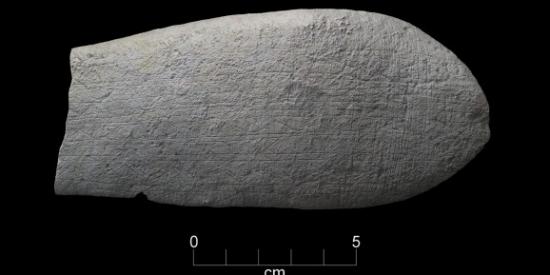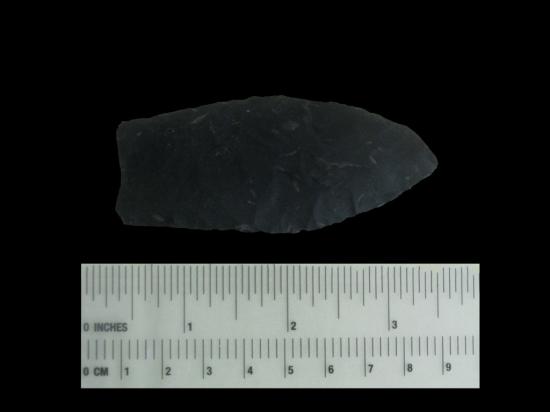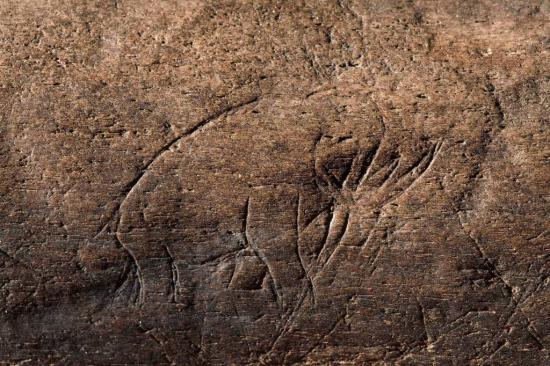To the origins of pre-columbian art
Sébastien Perrot-Minnot
Source - http://www.heritagedaily.com/2012/05/to-the-origins-of-pre-columbian-art/

Geometric engravings on a stone found at the Gault site. Photo: The Gault School of Archaeological Research.
Engravings, the earliest form of art in the American continent
Translated from Spanish.
Undeniably, the civilizations of Pre-Columbian America are more famous for their monuments and works of art, than for the great events of their history. It is due, on one hand, to the limitations of our knowledge in that last field, and on the other hand, of course, to the extraordinary Pre-Columbian artistic flourishing, whose creations expressed ideas and even complex messages, without being devoid, however, of aesthetic considerations.
The origins of this flourishing arouse, for a long time, inflamed debates. In the early 19th century, one of the great pioneers of the americanist archaeology, captain Guillaume Dupaix, didn’t hesitate to claim: “In spite of the scientific prejudices that reign for more than three centuries, with regard to the supposed youth of the American continent, the New World is as ancient as the Old one” (Antiquités mexicaines, 1834). Nevertheless, the advances of the research denied this theory: indeed, the human adventure is much more recent in America.
The earliest reported archaeological sites in the continent, and whose dating gains a broad consensus in the scientific circles, are between 15 000 and 16 000 years old. Nevertheless, more and more hints suggest the existence of older occupations, reaching perhaps 21,000 years in age.
The first colonizers of the New World took advantage of the isthmus that joined Asia and America during part of the last great glacial period, before being immersed about 11 600 years ago – at the end of the Late Pleistocene. Their odyssey was probably made easier by the practice of a coastal navigation. The hypothesis of a migration coming from Paleolithic Europe was also expressed, but until now, it couldn’t be demonstrated.
 Clovis point coming from Nahualá (Sololá) and exhibited at the Popol Vuh Museum (Guatemala). Photo: Sébastien Perrot-Minnot.
Clovis point coming from Nahualá (Sololá) and exhibited at the Popol Vuh Museum (Guatemala). Photo: Sébastien Perrot-Minnot.
In any case, the initial populations of America were composed of Homo Sapiens, that is to say, of modern humans. They had a language -or various languages- a family, clan or tribal social organization, religious beliefs, an elaborate lithic technology… and forefathers who have already left a profusion of sculpted, engraved and painted works, in the course of tens of thousands years.
But in the Western Hemisphere, which would be the earliest iconographic representations? To which period would they date back? These questions are complex. We can assume that the art entered America along with the first men, although for the moment, it’s impossible to prove. Evidently, since the Ice Age, the natural processes and the human activities have buried or destroyed big quantities of archaeological materials. On the other hand, among the remains that reached us, a lot divide the researcher’s opinions, because of the uncertainties that surround their contexts and ages.
It’s the case of the sculpture carved in the sacrum of an extinct species of camelid, found in 1870 in Tequixquiac (Mexico); and of petroglyphs of the Colorado Plateau (USA), which would show mammals of the order of the proboscidean – mammoths or mastodons. The Pleistocene dating of the Vero Beach (Florida, USA) proboscidean, incised in a fragment of fossilized bone, seems to be proved; nonetheless, the archaeological context of the artifacts, picked up by a “fossil hunter”, has not been documented.
 Incised bone of Vero Beach (Florida), representing a mammoth or mastodon. Photo: Chip Clark, Smithsonian National Museum of Natural History.
Incised bone of Vero Beach (Florida), representing a mammoth or mastodon. Photo: Chip Clark, Smithsonian National Museum of Natural History.
For other antiquities, the things are clearer. So, engraved stones and bone and ivory rods have been reported, on the occasion of excavations, at several sites in the United States, in levels of the Clovis culture – which developed at least between 13 300 and 12 900 years ago, from southern Canada to northern Venezuela. The figures are generally geometric; among those that cover dozens of stones of the Gault site, in Texas, the identification of plants has been proposed.
The bearers of the Clovis culture also colored bones and stone artifacts with red ochre, with an obviously ritual aim. As for the rest, the interpretation of these testimonies of the genesis of the Pre-Columbian world remains problematic. As the eminent French archaeologist André Leroi-Gourhan explained, “the Prehistoric man only left us truncated messages”.
Article published in the Revista D magazine, Prensa Libre (Guatemala), on May 27, 2012.
Link of the original article: http://especiales.prensalibre.com/revistad/2012/05/27/arqueologia.html
Thanks to Michael Collins and Clark Wernecke, University State University.